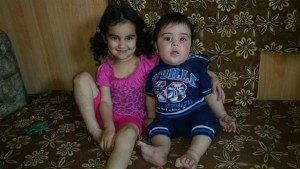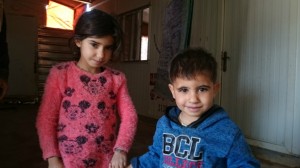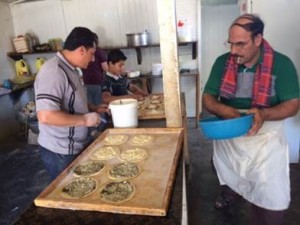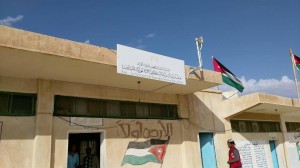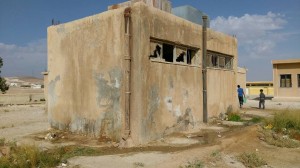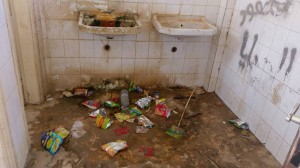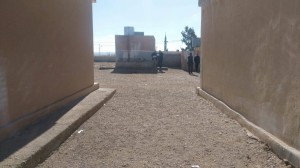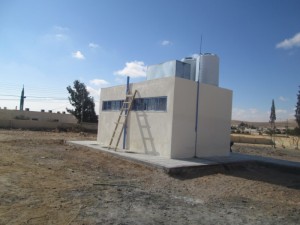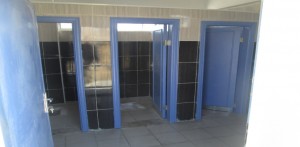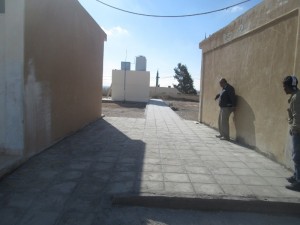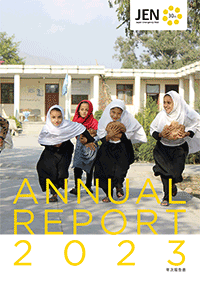Installation and repair of toilets in Za’atari refugee camp
My name is Mohannad Abu Siam. I am in charge of the assessment to install and repair toilets in Za’atari refugee camp. I would like to share about the project today.
Za’atari camp was established in 2012. People who evacuated here have lived in tents that were provided by UNHCR (United Nations High Commissioner for Refugees). Public sanitary facilities including toilets, showers and kitchens were also set up by UNHCR and shared within the area of the camp. However, residents in the camp have started to install their private toilets in their houses due to inconvenience of the shared ones and security issues at night.
Some of them made their own by themselves. Others asked people to make theirs. As a result, the number of people who use the shared toilets started to decrease, and the shared toilets became obsolete and were finally dismantled.
On the other hand, some families could not install their own toilets because they did not know the method or did not have money for them. Even if they could have installed the toilets, most of them did not meet the minimum hygiene requirements that are set by professionals in the camp. Toilets that are just holes in the floor, toilets without walls, or toilets without ventilation are examples of toilets that do not meet the requirements.
To solve these problems, JEN initiated a project to install and repair private toilets in April 2016. In the first stage, we installed toilets for families that do not already own them. In the second stage, we repaired existing toilets that do not meet the minimum requirements in the camp.
<At a house where we visited for the preliminary survey, the toilet has neither walls nor roof>
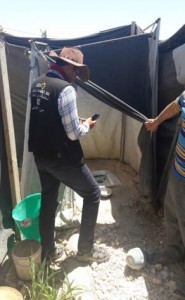
Three staff from the maintenance team and three staff from the mobilization team formed the assessment team and they took training courses before the assessment. The assessment was done in groups of two and was carried out based on the defined standard. First, the mobilization team evaluated whether the toilets needed repair. Then, they did a technical assessment and checked if the toilets were necessary for the residents.
We faced many challenges in this project. The biggest challenge was whether or not people accepted our preliminary assessment. Refugees who live in the camp wanted to use the building materials that were difficult to get to improve their living environment, instead of using the materials for toilets.
Among 1,850 households that we planned to assess, 50 households rejected JEN’s assessment and even partial repair. As a manager, I visited those families and explained JEN’s standard and the conditions of their toilets.
One family has changed their mind and accepted our proposal, however, another family intentionally broke their roof and doors that they wanted to be repaired. They tried to get new building materials by persuading JEN’s staff.
The following are some challenging cases.
Based on our assessment, one family needed a door and a wall to install a toilet. The family once accepted our proposal, however, changed their mind on the day of the construction, and requested to install the toilet outside of their house and not in the current place. I revisited the family and explained JEN’s standard and their toilet’s situation. However, they did not accept JEN’s proposal and refused to repair their toilet. In the end, persuasion by my supervisor and also by the maintenance team did not work.
Another challenge was limited time. In this project, we needed to cover all three areas in this Za’atari camp within 13 months. The maintenance team needed to work in different ways for each house because the situation was different for each of them. To adhere to our timeline as well as to ensure the quality of our work, we increased the number of maintenance staff and also carried out post-assessment after we installed the toilets.
Through this project, we did prior assessment for 2,300 households and also technical prior assessment for more than 1,850 households. In total, we set up 168 new toilets and repaired 1,783 toilets. This is a great achievement through our teamwork.
It has been two years since I have worked for JEN. I am proud that I can support Syrian refugees as a JEN staff member. After this toilet project, I am now supporting a project that builds water and sewerage networks. I would like to continue working at JEN and develop myself further in this humanitarian field.
【JEN is now accepting donations. Your help would be very much appreciated. DONATE here】
To develop the water supply systems
In the Zaatari Refugee camp, there has been an unparalleled construction project going on, which is to develop a large-scale water supply and sewerage system in the refugee camp.
Once the construction is over in 2018, drinking water will be distributed from the wells to each house directly. Also, dirty water will be recovered from each house to the sewerage treatment plant located at the southern part of the camp.
At the moment, water supply trucks put water into the water tanks in the camp almost everyday. Also, pump-up trucks draw dirty water from water-purification plants underground.
These tasks will no longer be necessary after the completion of the project. Operating costs, in addition to traffic accidents, are expected to be hugely reduced.
JEN’s main missions are to support the construction through involving the community, and to monitor the contractors.
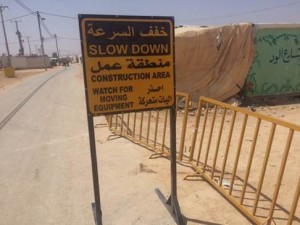
[For one thing, to make sure safety is strictly secured]
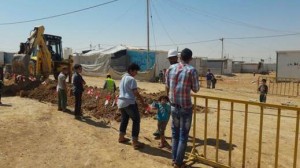
[For one thing, to inform the residents of the construction schedule and precautions beforehand]
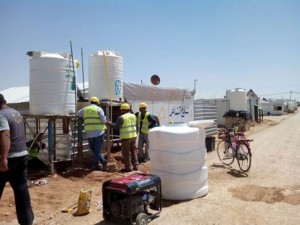
[For one thing, to make sure the employment conditions are firmly applied to the camp residents who are hired by the Jordanian contractors]
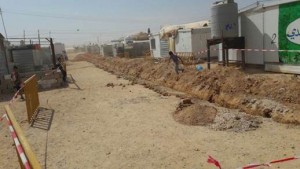
[Even in the weekends, JEN’s staff come to work for the monitoring activities]
The residents of the camp, support groups, the Jordanian constructors and the police office in the camp work together to develop this big project.
We examines how to involve the residents and how to create a scheme to let them positively participate in the activities so as to improve their own community.
JEN, together with other stakeholders, contributes to the accomplishment of this project.
【JEN is now accepting donations. Your help would be very much appreciated. DONATE here】
New arrivals
139, 120, 157 and 132 people who…
These numbers showed up in UNHCR’s biweekly report on the Za’atari refugee camp, respectively, in sequence, in the past two months.
Well then, who were behind the numbers?
The answer is newborn babies. Each number represents the number of babies born in 2 weeks , so about babies a day.
In the Za’atari refugee camp, children aged four and under account for about 20% of roughly 80,000 residents. Every day, babies are born in this camp, and they grow up here.
We recently talked to two families about raising their children in a refugee camp.
Mother of Taim, aged six months, said:
“I came to the camp when my eldest child Dana was two months old. I gave birth to Taim at a maternity clinic in the camp.
I felt relieved at that time, because I had given birth to Dana in the basement of a hospital which was under attack in the middle of a war. We are safe here.
There are schools and medical services. I have no particular concern about my children growing up in the camp. In the future, when peace comes, I want to show my children my hometown, a suburb of Damascus in Syria which neither of them have seen.
Father of Ala’a, aged 3, said:
“I have 10 children aged three to 20. My youngest, Ala’a, was born in the camp. He’s stepped out of the camp three times or so.
I took him to my relative’s farm in the neighborhood. Ala’a loves animals. In the farm, he looked at the cattle and sheep until it got dark. To go outside the camp, we need permission.
We also need to pay for our travel so I can’t afford to take my children out of the camp very often. Life here is like a life of captivity, and raising children is difficult.
My three eldest sons quit school. Because I am worried about their future, I want to give them opportunities to take part in vocational training programs.”
Children who are born and grow up in refugee camps will each have a different life experience but hopefully one where they each have the chance to reach their full potential and visit their family’s home country to learn about its culture and history.
【JEN is now accepting donations. Your help would be very much appreciated. DONATE here】
Residents take a step to protect their community (Emergency training)
Here in the Za’atari refugee camp, we are getting used to seeing the thermometer hit 25 Celsius, cutting the spring short and heading into the early summer. All this warm weather makes people become more active.
Just take a look at this pizza restaurant. Staff are busy making and delivering pizzas ordered by local residents and by people working to provide support in the area.
He is sliding pizzas into the oven. This restaurant’s pizzas are great.
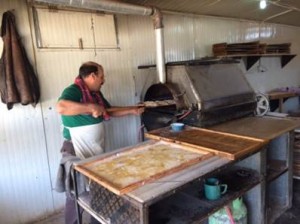
[To cook pizzas, the restaurant uses fire]
Now, let’s get back to the topic of the weather. There is also a change in humidity. The air is very dry. What if there is a fire? The fire could engulf the camp quickly.
To prevent such incidents, Jordan’s security authorities held a training seminar last month on how to use fire extinguishers. The seminar was for residents working under the “cash for work” programs.
Supported by humanitarian aid organizations, such programs provide temporary employment in public projects, which can be seen everywhere in the camp.
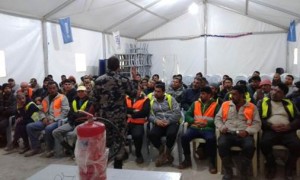
[Residents are listening to explanations by the instructor]
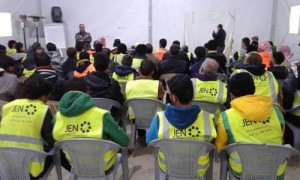
[Workers engaged in JEN's cash-for-work support projects]
Since the Za’atari refugee camp was set up in the summer of 2012, JEN has had in-depth discussions about how we can help refugees develop a self-sustainable community. Five years later, the training seminar showed that the refugees are thinking in the same way.
Their mindset is to protect their community by themselves. This is a small but very important step to become self-sustainable, and we are pleased to have had the chance to see it.
【JEN is now accepting donations. Your help would be very much appreciated. DONATE here】
Sad Al-Sultani Boys’ Junior High School
[Sad Al-Sultani Boys’ Junior High School]
Sad Al-Sultani Boys’ Junior High School is in Karak district 100km south of the capital city Amman. The school was established by the Department of Education in the 1970s. It is located in a desert town so many of the students come from Bedouins and neighboring tribes.
The school facilities, due to poor maintenance were in a terrible condition with broken windows. The restrooms were particularly bad, so bad that teachers had to share the restrooms at their own homes with their students. It was an embarrassment to the school managers. They needed an idea on how to improve the situation.
[Abandoned restroom in the school]
[Inside the school restroom]
[Walkway before being paved]
The JEN engineer team visited Sad Al-Sultani Boys’ Junior High School in order to assess the repair priorities and figured out that it was necessary to renovate the restroom facility.
[Restroom being renovated]
[Inside the renovated restroom]
The whole restroom facility was repaired including windows, doors, seats, floor, tiles on the wall, water tanks, as well as the water supply and sewerage system. Work did not stop there, the walkway to restroom was repaired too.
[Walkway after being paved]
【JEN is now accepting donations. Your help would be very much appreciated. DONATE here】

![Jordan [Syrian refugees]](/en/project/images/mainimg_project_jordan.jpg)
